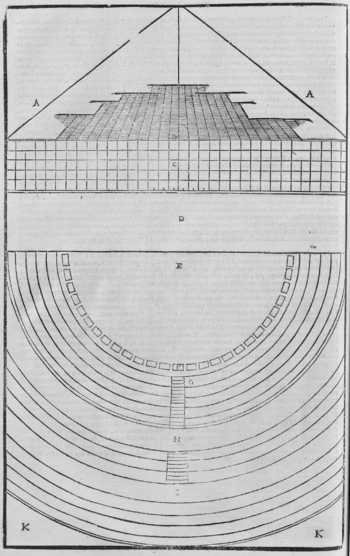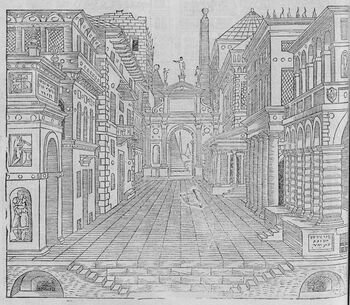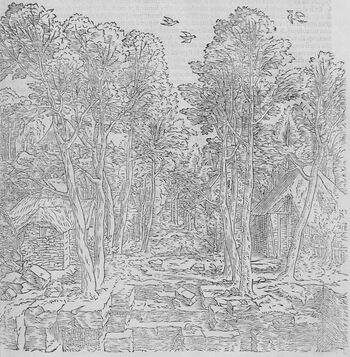Serlio’s scenes for comedy, tragedy and satire[edit]
The 16th century painter and architect Sebastiano Serlio was the first to codify and publish drawings of the three types of classical set designs: comedy, tragedy and satire. These designs had a great influence on stage design across Europe.
Sebastiano Serlio (Q568) was an Italian painter and architect, who gave a systematic description of classical architecture in his influential treatise Seven Books of Architecture (Q30606, 56). He pioneered the use of high-quality illustrations to supplement the text, and his treatise, both practical and theoretical, catered explicitly to the needs of architects, builders, and craftsmen.
The books, published between 1537 and 1551, cover geometry, perspective, Roman antiquity, the orders of architecture and church design as well as antique principles of symmetry and proportion. Significantly, the last few pages of the second book, ‘On Perspective’, contain drawings of three theatrical scenes (comic, tragic, and satiric) and a stage plan and cross section which were highly influential in Renaissance theatre. For the theatrical space Serlio proposes a semi-circular auditorium, surely similar to the one he had built in Ca Porto, in Vicenza. He recommends placing the stage at eye level and with a flat proscenium area and the rest sloped 1 in 9. This area of slope he grids in exaggerated perspective, to create the so-called houses in relief and the illusion of greater depth.
For the tragic scene with its majestic palaces, he explains that it must represent the architectural nobility according to the social elevation of the characters, with a look towards classical antiquity and creating the sensation of the ideal city for whoever appears on the scene.
The comic scene with a decoration of ordinary town houses must show the daily life of the different characters. There must be variation of materials and proportions in the buildings. We can add that the aesthetics used in the buildings has a correlation with what is found in his home town, Bologna.
In the satirical scene with its landscape of trees, hills and huts, the entire space is full of natural elements, in addition to showing primitive constructions to represent the Arcadian paradise as Vitruvius proposes.
Serlio dedicates his second book to perspective representation and theatre and published it in 1545, when he moved to France. This second book, understood by its author as a manual, deals with general perspective, relief perspective, stages, theatres and scenic apparatus. The set of books was inspired by those of Vitruvius (Q467). Furthermore, he is considered one of the first decorative mannerists because of his innovative view of theatrical appearance.
Serlio also describes how he and probably other set designers made and painted their sets. Thus, we know that the sets combined the painted perspective with certain three-dimensional elements. The flats nearest the front were on the flat floor, arranged at an angle to simulate the corners of houses. These nearer houses had cornices and architectural decorations, which were not present on those at the back of the stage. There, painted shading created appearance of the overhangs. The bottom edges of the flats were angled to fit the slope of the raked stage, and the top edges were also angled, to make the perspective as complete as possible. Serlio intended to generate in the spectator the sensation of an infinite space in which the theatrical action is located.
Serlio also provided a great deal of information on how to imitate thunder, lightning, how to move mechanical figures of men, animals or planets by means of invisible wires and on the lighting of the scene. In addition, he evaluated everything related to the scene in terms of invoking the desired emotions in the viewer, according to the type of stage action.
Serlio’s volumes were highly influential as a conveyor of the Italian Renaissance style, and quickly became available in a variety of languages like Flemish, German, French, Dutch, English and Spanish, with the same illustrations as the original Italian editions. Sebastiano Serlio greatly helped the consolidation of perspective as a compositional instrument within set design carried out throughout the Renaissance.



